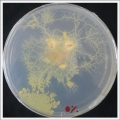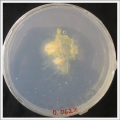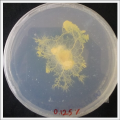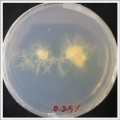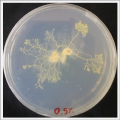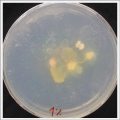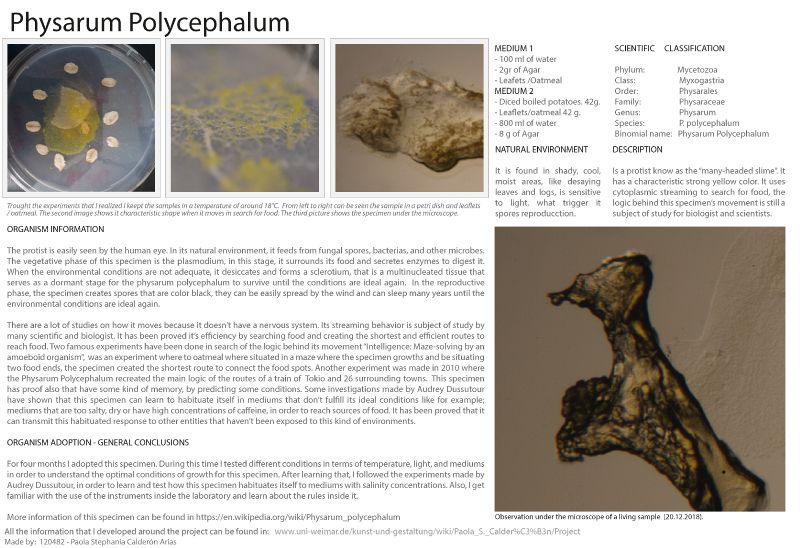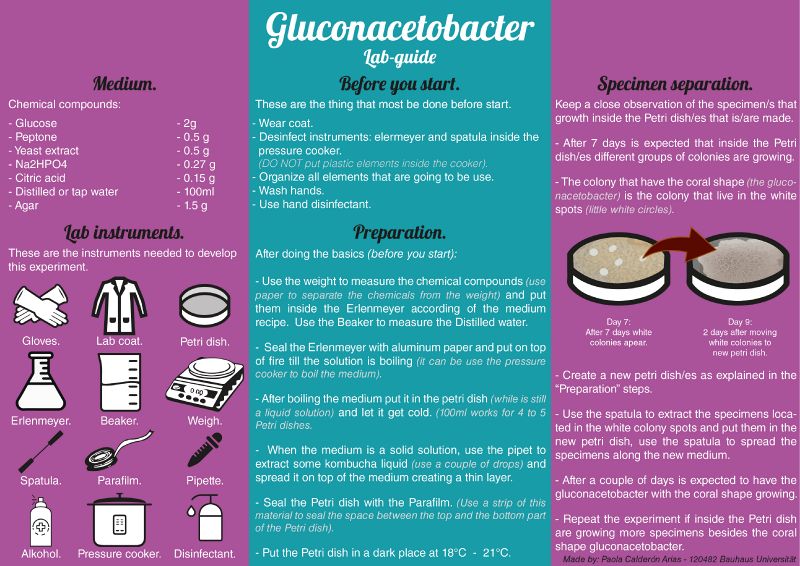GMU:DIY Bio: doing things with biology/Paola Stephania Calderón: Difference between revisions
No edit summary |
No edit summary |
||
| (174 intermediate revisions by 2 users not shown) | |||
| Line 1: | Line 1: | ||
==INTRODUCCTION== | |||
In this class, I develop the basic knowledge around the work inside a laboratory, I acquired different kinds of knowledge around different specimens that were adopted and as a final result, I made two projects. The '''project idea 1: ''(teaching Physarum Polycephalum to live in salinity mediums)'' ''' is the result of the knowledge that was acquired around the selected specimen ''Physarum Polycephalum'' in the class ''DIY: Bio: doing things with biology'' and the experimentation made in the class ''Experimental microbiology''. The '''project idea 2: ''(insolation of gluconacetobacter with coral shape)'' ''' is the result of the knowledge build during the class ''DIY: Bio: doing things with biology''. During this class, I developed other experiments that build my knowledge around the work inside the laboratory, the cultivation of different kinds of specimens and techniques around the lab. work. | |||
==PROJECT IDEA 1== | |||
The idea is to compare how the specimen ''Physarum Polycephalum'' grows in normal conditions, and how trained specimens behave when they have the possibility to change into a salinity environment. | |||
A neutral medium was created, and a photo sequence video was created to see how the specimen grows in normal conditions, and another medium was created with stripes of different salinity mediums from 0% to .5% to see how the trained specimens behave. The following two videos show the results of both experiments. | |||
[[ | |||
[[File:62h normal medium.mp4|1500px]] | |||
62h Physarum Polycephalum growth in neutral environment video | |||
[[File:52h salinity medium.mp4|1500px]] | |||
52h Physarum Polycephalum growth in salinity mediums video ''(from 0% to 0.5% salinity)'' | |||
Photogallery of Physarum Polycephalum living in different salinity porcentage mediums. | |||
<gallery> | |||
File:0% salinity.png | |||
File:0.062% salinity.png | |||
File:0.125% salinity.png | |||
File:0.25% salinity.png | |||
File:0.5% salinity.png | |||
File:1% salinity.png | |||
</gallery> | |||
''The initial experiment of teaching Physarum Polycephalum to live in salinity mediums was made in the class GMU: Experimental Microbiology, the experiment, and results can be seen in the following link: [https://www.uni-weimar.de/kunst-und-gestaltung/wiki/Paola_S._Calder%C3%B3n/Project:_Specimen_%27%27Physarum_Polycephalum%27%27.] | |||
''All experiments made in the class "Experimental Microbiology" can be seen at:'' | |||
https://www.uni-weimar.de/kunst-und-gestaltung/wiki/Paola_S._Calder%C3%B3n | |||
RELATED EXPERIMENTS | |||
>> ''First approximation to the organism'' | |||
The initial approximation to the specimen was made in the class: ''DIY BIO: doing things with biology''. In this class three different kinds of samples were made the same day, with the same conditions and the same medium, but they develop in different ways, the following link shows the diary of work for each experiment that was made. From this three experiments, I learned how to cultivate physarum/polycephalum how it grows, the type of conditions that it needs (medium) to grow up and the temperature that it also needs to grow. | |||
Datasheet of ''Physarum Polycephalum:'' | |||
[[File:DATA sheet Physarum Polycephalum.jpg|800px]] | |||
Links to further experiments with Physarum Polycephalum: | |||
[[/Farming 1]] ''Farming from a living sample'' | |||
[[/Farming 2]] ''Farming from a sleeping sample'' | |||
[[/Farming 3]] ''Farming from a combined sample'' | |||
>> ''Second approximation to the organism'' | |||
This link contains the knowledge, results and the experiments made in order to create an ideal medium for faster growth base in the previous investigation of Caicedo. | |||
[[/20.11.2018]] ''Growing Polycephalum/physarum from Caicedos investigation'' | |||
==PROJECT IDEA 2== | |||
The first approximation is to recreated and find a method in order to cultivate a microorganism with a coral shape. | |||
The project idea is to create a guide based on the recreation of the experiment made before with the kombucha. The following guide includes the information of the chemical compounds to create the medium, the instruments needed to recreate the experiment, instructions before starting to work and instructions of how to create the medium and insolate the gluconacetobacter. | |||
[[File:Gluconacetobacter guide.jpg|800px]] | |||
The diary of work made in the first approximation to isolate a specimen ''(with coral shape)'' can be seen in the following link. | |||
[[/30.10.2018]] ''Separation of one specimen - kombucha'' Link to the first approximation to this experiment. | |||
==FURTHER EXPERIMENTS== | |||
During this class, a lot of experiments were made in order to understand the lab rules, learn different techniques inside the lab, for example how to grow different kinds of specimens, observation under the microscope, and others. | |||
''These experiments can be seen in the following links:'' | |||
[[/16.10.2018]] ''Introduction of the course'' | |||
[[/06.11.2018a]] ''Growing Mycelium'' | |||
[[/06.11.2018b]] ''Capturing electric potentials in organic matter'' | |||
[[/18.12.2018]] ''Observation of specimens under the microscope'' | |||
[[/22.01.2019]] ''Gelelectrophoresis'' | |||
Latest revision as of 10:51, 3 April 2019
INTRODUCCTION
In this class, I develop the basic knowledge around the work inside a laboratory, I acquired different kinds of knowledge around different specimens that were adopted and as a final result, I made two projects. The project idea 1: (teaching Physarum Polycephalum to live in salinity mediums) is the result of the knowledge that was acquired around the selected specimen Physarum Polycephalum in the class DIY: Bio: doing things with biology and the experimentation made in the class Experimental microbiology. The project idea 2: (insolation of gluconacetobacter with coral shape) is the result of the knowledge build during the class DIY: Bio: doing things with biology. During this class, I developed other experiments that build my knowledge around the work inside the laboratory, the cultivation of different kinds of specimens and techniques around the lab. work.
PROJECT IDEA 1
The idea is to compare how the specimen Physarum Polycephalum grows in normal conditions, and how trained specimens behave when they have the possibility to change into a salinity environment.
A neutral medium was created, and a photo sequence video was created to see how the specimen grows in normal conditions, and another medium was created with stripes of different salinity mediums from 0% to .5% to see how the trained specimens behave. The following two videos show the results of both experiments.
62h Physarum Polycephalum growth in neutral environment video
52h Physarum Polycephalum growth in salinity mediums video (from 0% to 0.5% salinity)
Photogallery of Physarum Polycephalum living in different salinity porcentage mediums.
The initial experiment of teaching Physarum Polycephalum to live in salinity mediums was made in the class GMU: Experimental Microbiology, the experiment, and results can be seen in the following link: [1]
All experiments made in the class "Experimental Microbiology" can be seen at:
https://www.uni-weimar.de/kunst-und-gestaltung/wiki/Paola_S._Calder%C3%B3n
RELATED EXPERIMENTS
>> First approximation to the organism
The initial approximation to the specimen was made in the class: DIY BIO: doing things with biology. In this class three different kinds of samples were made the same day, with the same conditions and the same medium, but they develop in different ways, the following link shows the diary of work for each experiment that was made. From this three experiments, I learned how to cultivate physarum/polycephalum how it grows, the type of conditions that it needs (medium) to grow up and the temperature that it also needs to grow.
Datasheet of Physarum Polycephalum:
Links to further experiments with Physarum Polycephalum:
/Farming 1 Farming from a living sample
/Farming 2 Farming from a sleeping sample
/Farming 3 Farming from a combined sample
>> Second approximation to the organism
This link contains the knowledge, results and the experiments made in order to create an ideal medium for faster growth base in the previous investigation of Caicedo.
/20.11.2018 Growing Polycephalum/physarum from Caicedos investigation
PROJECT IDEA 2
The first approximation is to recreated and find a method in order to cultivate a microorganism with a coral shape.
The project idea is to create a guide based on the recreation of the experiment made before with the kombucha. The following guide includes the information of the chemical compounds to create the medium, the instruments needed to recreate the experiment, instructions before starting to work and instructions of how to create the medium and insolate the gluconacetobacter.
The diary of work made in the first approximation to isolate a specimen (with coral shape) can be seen in the following link.
/30.10.2018 Separation of one specimen - kombucha Link to the first approximation to this experiment.
FURTHER EXPERIMENTS
During this class, a lot of experiments were made in order to understand the lab rules, learn different techniques inside the lab, for example how to grow different kinds of specimens, observation under the microscope, and others.
These experiments can be seen in the following links:
/16.10.2018 Introduction of the course
/06.11.2018a Growing Mycelium
/06.11.2018b Capturing electric potentials in organic matter
/18.12.2018 Observation of specimens under the microscope
/22.01.2019 Gelelectrophoresis
